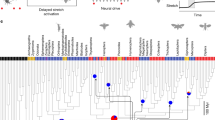Summary
-
1.
A flying locust responds to a rhythmically flashing light by adopting a wingbeat frequency equal to the flash frequency, if the flash frequency is not too different from the initial wingbeat frequency (Fig. 2). During this response, the wingbeat cycle maintains a particular timing relative to the light cycle (Fig. 1).
-
2.
This oscillator coupling occurs because each light flash, by exciting the elevator motor neurons and/or the depressor motor neurons, causes an acceleration of the flight cycle by an amount that depends on the timing of the flash relative to the flight cycle (Figs. 4 and 5). The phase of the flight cycle relative to the flashes changes until it reaches a value at which the acceleration in each cycle is just sufficient to result in a flight system frequency equal to the stimulus frequency. The resulting constant phase relationship is stable only if slight fluctuations in the timing of the flight cycle are self-correcting. As predicted theoretically self-correction occurs in that portion of the cycle in which later stimuli result in smaller accelerations of the flight cycle.
-
3.
This mechanism of oscillator coupling has been demonstrated by a similar method of analysis for other biological oscillators (Moore et al., 1963; Enright, 1965). It is shown here how the method of analysis can be extended to certain cases of reciprocally coupled oscillators.
-
4.
Some of the data suggest that there may be only one or two layers of neurons in the central nervous network which generates the motor output pattern in flying locusts.
Similar content being viewed by others
References
Aschoff, J. (ed.): Circadian clocks. Amsterdam: North-Holland Publishing Co. 1965. 479 pp.
Enright, J. T.: Synchronization and ranges of entrainment. In: Circadian clocks, ed. J. Aschoff, p. 112–124. Amsterdam: North-Holland Publishing Co. 1965.
Hisada, M., M. Tamasige, and N. Suzuiki: Control of the dragonfly Sympetrum darwinianum Selys I. Dorsophotic response. J. Faculty Sci., Hokkaido Univ. Series VI, Zool. 15, 568–577 (1965).
Holst, E. von: Die relative Koordination als Phänomen und als Methode zentralnervöser Funktionsanalyse. Ergebn. Physiol. 42, 228–306 (1939).
Hyde, J. E., and E. Tan: Characteristics of brainstem-evoked stimulus-bound respiration rate in anesthetized cats. Exp. Neurol. 14, 396–407 (1966).
Iwasaki, S., and D. M. Wilson: Neuropile potentials following wing sensory nerve stimulation in locusts. Comp. Biochem. Physiol. 17, 693–695 (1966).
Josephson, R. K.: Mechanisms of pacemaker and effector integration in coelenterates. Symp. Soc. exp. Biol. 20, 33–47 (1966).
Kneutgen, J.: Beobachtung über die Anpassung von Verhaltensweisen an gleichförmige akustische Reize. Z. Tierpsychol. 21, 763–779 (1964).
Moore, G. P., O. H. Perkel, and J. P. Segundo: Stability patterns in interneuronal pacemaker regulation. Proc. of San Diego Symposium for Biomedical Engineering, 184–193 (1963).
Pabst, H.: Elektrophysiologische Untersuchung des Streckrezeptors am Flügelgelenk der Wanderheuschrecke Locusta migratoria. Z. vergl. Physiol. 50, 498–541 (1965).
Pavlidis, T.: A mathematical model for the light affected system in the Drosophila eclosion rhythm. Bull. Math. Biophysics 29, 291–310 (1967).
Waldron, I.: Neural mechanism by which controlling inputs influence motor output in the flying locust. J. exp. Biol. 47, 213–228 (1967).
Wilson, D. M.: The central nervous control of flight in a locust. J. exp. Biol. 38, 471–490 (1961).
—, and E. Gettrup: A stretch reflex controlling wingbeat frequency in grasshoppers. J. Exp. Biol. 40, 171–185 (1963).
—, and I. Waldron: Models for the generation of the motor output pattern in flying locusts. Proc. I.E.E.E. (in press) (1967a).
— Motor neuron interactions and diversely patterned activity in the locust flight control system (in manuscript). (1967b).
—, and T. Weis-Fogh: Patterned activity of co-ordinated motor units, studied in flying locusts. J. exp. Biol. 39, 643–667 (1962).
—, and R. J. Wyman: Motor output patterns during random and rhythmic stimulation of locust thoracic ganglia. Biophys. J. 5, 121–143 (1965).
Author information
Authors and Affiliations
Additional information
It is a pleasure to thank Dr. Donald Wilson, who has been a most stimulating and helpful teacher. I am grateful to Dr. Horace Barlow and Mr. Michael Murray for their criticisms of the manuscript. Locusts were kindly supplied by the Anti-Locust Research Centre, London. Financial assistance is acknowledged from the University of California (Berkeley) Computer Center, from an NSF predoctoral fellowship to the author, and from research grants to Dr. Wilson from NTH (NB-03927) and the Air Force (AFOSR-1246).
Rights and permissions
About this article
Cite this article
Waldron, I. The mechanism of coupling of the locust flight oscillator to oscillatory inputs. Z. Vergl. Physiol. 57, 331–347 (1968). https://doi.org/10.1007/BF00303060
Received:
Issue Date:
DOI: https://doi.org/10.1007/BF00303060




